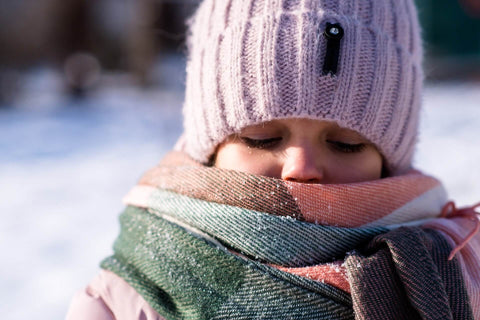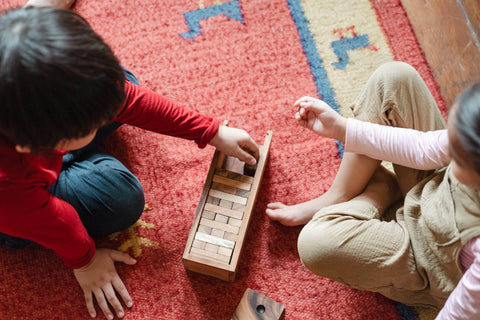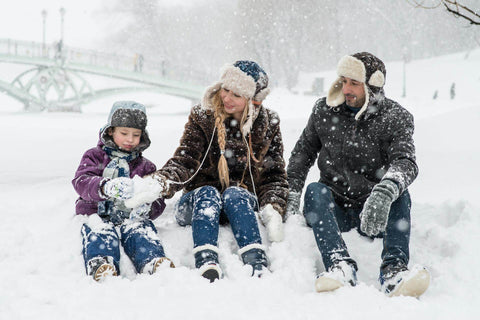
1. Winter Clothing Basics for Toddlers
Winter is a season that presents special challenges when it comes to clothing for small children. The right winter clothing is crucial to ensuring the health and well-being of your little ones. In this section we will explain the basic principles that should be followed when dressing toddlers in winter.
Young children have more sensitive skin and are more susceptible to cold than adults. Their body temperature can drop more quickly and therefore it is essential to adequately protect them from winter conditions. The right winter clothing not only offers comfort, but also protection against hypothermia and other weather influences.
2. The importance of materials and fit
Choosing the right materials is crucial. Wool, for example, is an excellent material for winter as it regulates temperature and keeps you warm even when it is damp. When it comes to the fit, it is important to ensure that clothing offers enough space to allow good air circulation while at the same time maintaining body heat and temperature.
Wool has the amazing ability to insulate in both cold and warm weather. It retains your child's body heat while wicking away moisture to prevent excessive sweating.
In addition to wool, synthetic materials such as fleece and thinsulate are popular. They offer good insulation properties and are often lighter than wool. Make sure materials are breathable to avoid moisture buildup.
3. Snowsuits and jackets
In the cold winter months, it is crucial that children are adequately protected from low temperatures, snow and moisture. Snow clothing and jackets play a central role here as they provide an important barrier between the child and adverse weather conditions.
Snowsuits are an excellent choice for keeping children warm and dry. They offer all-round protection as they cover the child's entire body. Here are some important aspects to consider when choosing a snowsuit:
Waterproof and breathable: A quality snowsuit should be waterproof to ensure that no water can penetrate. At the same time, breathability is important to ensure that moisture can escape from the inside so that the child does not sweat.
Insulation: The insulation of the snowsuit is crucial to keeping the child warm. Wool is an excellent material here as it keeps you warm even when wet. Make sure the snowsuit is adequately lined.
Freedom of movement: Despite the protection, children should have sufficient freedom of movement. Make sure that the snowsuit is not too tight and offers enough room for movement.
In milder winter conditions, a high-quality winter jacket can also be a good choice. Here are some things to consider:
Insulation and material: A winter jacket should be made of insulating material that protects against the cold. Look for high-quality fillings such as down or synthetic alternatives.
Wind and water repellency: The jacket should be wind and water repellent to protect the child from the elements. Hoods are particularly useful for keeping your head warm.
Layering Options: A jacket allows you to wear a layer underneath to adjust the warmth as needed. This is particularly useful when temperatures change during the day.
4. Accessories for warmth and protection
In addition to basic clothing, accessories such as hats, gloves and scarves are important. They protect sensitive body parts such as ears, hands and neck from cold and wind. Special footmuffs are a good choice for babies in the baby seat or stroller.
If you are looking for high-quality accessories for your child, you can check out the following products from KraftKids:
- Scarf for children in winter
- Triangular scarf
- Baby blanket muslin grey dandelions
- Baby blanket for baby seat summer muslin gray dandelions
These accessories not only provide protection, but also style and comfort for your child during the cold winter months. Remember, the right choice of accessories can help keep your child warm and comfortable while they play outside or are out and about.
5. The onion look – flexibility in changeable weather
The onion look makes it possible to react quickly to changing winter weather conditions. By putting on and taking off individual layers, the clothing can be flexibly adapted to the child's temperature and activity.
The big advantage of the onion look is its flexibility. When temperatures rise or during more intense physical activity, the child may remove one or more layers to avoid overheating. If it cools down or the activity slows down, an additional layer can be put back on to retain warmth. This method ensures that the child is always appropriately and comfortably dressed in different weather conditions and for different activities.
In addition, the onion look also offers the opportunity to adapt the clothing to personal preferences and the child's individual heat level. Some children freeze more quickly and therefore need more or warmer layers, while others need less insulation. Overall, the onion layer principle offers a practical, flexible solution to optimally equip children for the challenges of changing winter weather conditions.
6. Special considerations for babies
Baby clothing requires special attention. Baby clothes should be light, warm and breathable. Since babies cannot yet regulate their own body temperature, it is important to keep them warm and dry without overheating them.
Natural materials such as cotton or merino wool are ideal for winter as they retain heat while wicking moisture away from the body. It is also important that clothing be free of harsh seams or tags that could irritate the skin. In addition, parents should make sure that baby clothes are easy to put on and take off in order to cause as little discomfort to the little ones as possible.
In addition to functionality, security also plays a major role. Garments with small buttons or loosely sewn accessories should be avoided as they can pose a choking hazard. Instead, larger, securely fastened buttons or Velcro are a good choice.
7. Play and exercise in winter
When playing outside during the winter months, it is crucial that winter clothing not only keeps you warm, but also provides enough freedom of movement. Children who play outside should be able to move freely and unhindered. This is important to stay active and thereby generate additional body heat that protects you from the cold. The right winter clothing for children should therefore consist of several layers that provide insulation and comfort without restricting movement. Breathable pads that wick away moisture are also beneficial as they prevent children from getting wet through sweat and becoming more vulnerable to the cold. It is also important that clothing is adaptable and can be easily adjusted to changing temperatures and activity levels. Winter accessories such as gloves, hats and scarves should also not restrict freedom of movement and at the same time offer effective protection against the cold.
8. Care and storage of winter clothing
After the winter season, it is crucial to carefully care for and store children's winter clothes to ensure their longevity and readiness for next year. This includes first washing the garments thoroughly according to the care instructions on the label. It is important to use special detergents when dealing with delicate materials such as wool or technical fabrics, which are often found in winter clothing.
After washing, clothing should be completely dried before storing. This prevents the formation of mold and unpleasant odors. For storage, it is recommended to use breathable storage bags or boxes to protect clothes from dust and moths. Another important point is to store in a cool, dry place away from direct sunlight to avoid fading and material damage.
It can also be helpful to hang larger items of clothing, such as coats or snow gear, rather than folding them to avoid wrinkling and damaging the material. For smaller items such as gloves, hats and scarves, organizing them in separate compartments or boxes is a good idea to keep things tidy and keep track.
If you are looking for accessories for your child, you have come to the right place - take advantage of what KraftKids has to offer.
FAQ
What does a toddler wear in winter?
A toddler wears multiple layers in the winter: a moisture-wicking base layer, an insulating middle layer, and a water-repellent outer layer. Accessories like hats and gloves are also important.
What to wear with 2 year olds in winter?
Two-year-olds should be dressed in layers, starting with a thin base layer, followed by a warming layer and a weatherproof outer layer. Matching winter accessories such as hats and gloves should not be missing.
What do you dress a toddler in at 0 degrees?
At 0 degrees, several layers are required: warm underwear, an insulating middle layer and a water-repellent outer layer. Important accessories include warm hats, gloves and, if necessary, a face mask.



